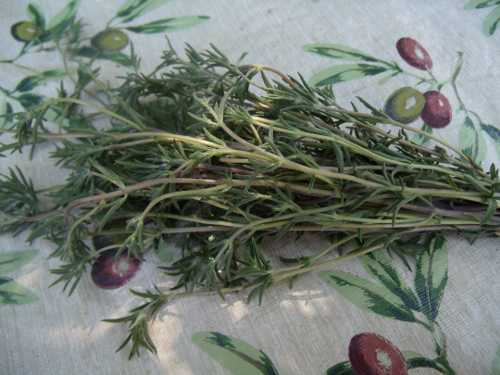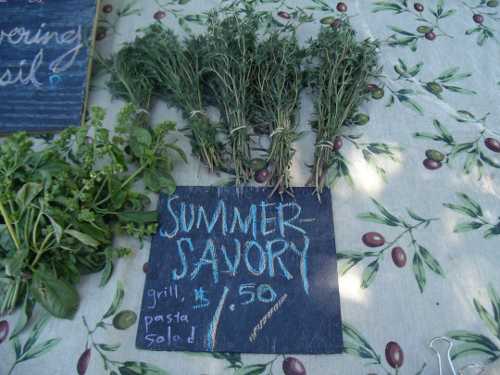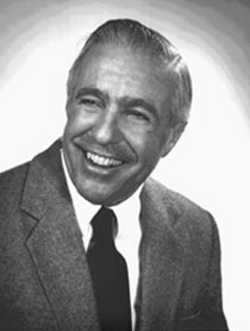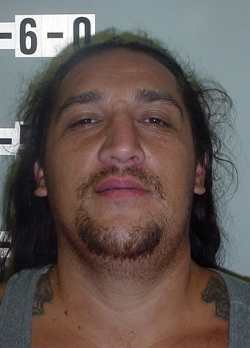
The delicate, feathery leaves of summer savory, shown here, are more tender than the tough leaves of their relative, winter savory. Photo by Esther Oertel.
As I was perusing farmers’ market stalls not too long ago, sweet little bundles of summer savory caught my eye.
While not as popular as herbs such as thyme and basil in today’s kitchens, savory once held a place of dominance in the cooking of Europe, so much so that its name refers not only to the herb, but an entire segment of cooking.
There are about 30 species in savory’s genus; however, two of them, summer savory, an annual, and winter savory, a perennial, are best known to us and used for cooking. Jointly, they’re referred to as “the savories.”
This herb can pack a punch, particularly the more strongly flavored winter savory. Native to a swath of southern Europe from Spain to Turkey, the two savories were the strongest herbs available to Europeans for cooking until world exploration and trade brought such spices as black pepper to the table.
Since both savories are available fresh from mid spring through fall, one might wonder about their seasonal names. The monikers likely developed because more gently flavored summer savory marries well with the fresh produce available in the summer, while the stronger flavor of winter savory is best with hearty winter dishes.
Savory is nicknamed “the bean herb” because it goes so well with all kinds of beans, both fresh and dried. The name for savory in German is bohnenkraut, meaning just that, bean herb, and in Italian cuisine, savory is a staple ingredient in bean dishes.
And what of the differences between the two species?
Both savories have wiry stems and small, needle-like leaves, similar to rosemary, to which they’re related; however, the leaves of summer savory are tender, enough so to add fresh to salads, while winter savory sports tough leaves, making it useful in dishes that require long cooking.
The stems of winter savory are woodier than those of its summer savory cousin. It may be planted as a hedge, and was popular in the intricate knot gardens of Tudor England.
As a perennial, winter savory will return each year from the same root and should provide pungent leaves for cooking in all but the coldest months. In the mild climate of coastal California, it’s an evergreen.
In contrast, summer savory must be replanted in the garden each year.
In the kitchen, the two are generally interchangeable, but less of the more pungent winter savory should be used in recipes. It has a more intense version of summer savory’s peppery notes and its subtle hints of dill, mint and pine.
A tablespoon of chopped fresh summer savory translates to a teaspoon of winter, a difference of two thirds.
Savory was a popular herb in ancient Rome, where it flavored vinegar as one of their main condiments and was a component in many of their sauces. Adding a sprig of summer savory to infuse its herbal notes into vinegar is a great way to enjoy its flavor throughout the year.
The genus’ Latin name, Satureja, is attributed to the Roman writer, Pliny, and is a derivative of the word “satyr,” a mythical half man, half goat. According to the lore surrounding these creatures, the satyrs lived in meadows of savory, making them passionate, thus fueling a persistent belief in savory as a love potion. Some believed that summer savory fueled passion, while winter savory decreased it.
San Francisco was originally named Yerba Buena because of a relative of summer and winter savory native to the Pacific coast. Early settlers dried the herb and drank it as tea to cure a variety of ailments, thus earning the name, which translates to “good herb.”
Both savories keep their character when dried, and savory is often found in the dried blends that mimic the herbs of Provence, France.
Summer savory in its fresh form may be bundled with herbs such as rosemary, thyme, oregano and sage to flavor soups and stews. Winter savory is not recommended, as its pungency will overtake the other herbal flavors.

These bundles of summer savory were offered for sale by Full Moon Farms at the Lake County Farmers' Finest market at Steele Winery in Kelseyville, Calif. Photo by Esther Oertel.
In an effort to determine whether dried spices marketed as savory contain the winter or summer species, I found that it depends on the company. Spice Islands, for example, uses summer savory and labels it as such, while McCormick bottles the winter species without identifying it that way. Some companies that deal in online bulk herbs don’t differentiate between the two.
Fresh springs of either of the savories may be frozen for later use in cooking. As well, the herb may be whirred in a blender with a little water to make a thick slurry and frozen in ice cube trays, similar to basil. Once frozen, transfer to zipper sealed bags for freezer storage.
Fresh herbs are best kept in the fridge standing in water like a bouquet or wrapped in a slightly damp paper towel and stored in a plastic bag.
The savories’ pungent taste complements foods with milder flavor profiles, such as potatoes or beans. Sprigs of savory add a wonderful flavor to slow-cooked dried beans, and chopped fresh savory may be mixed with olive oil, salt, and pepper to make a flavorful rub for roasted potatoes.
In Atlantic Canada, summer savory is used in the same way sage is elsewhere, such as for the main flavoring ingredient for dressing for fowl.
In addition to its popularity in Italy and Germany, summer savory is popular in various Eastern European cuisines, including as a flavoring for sausages.
In Bulgaria, salt and pepper is replaced on tables with a combination of salt, paprika and savory, known there as sharena sol, meaning colorful salt.
Other uses include as a flavoring in tomato dishes, as a robust alternative to dill in sour cream dips, as a component in marinades and vinaigrettes, and as a flavoring for fish, especially when combined with garlic, bay leaves and lemon juice.
A classic summer dish is green beans flavored with summer savory. These fresh beans are available now at farmers’ markets, and if you’re lucky, you may find a bunch of fresh savory to go along with them.
To make it, blanch beans first in boiling water until tender crisp, about six to eight minutes, depending on the size of the beans. Rinse with cold water if using immediately, or plunge into an ice water bath if holding for later use.
Sauté blanched beans in butter or olive oil and chopped fresh summer savory, about two tablespoons for every two pounds of beans, then season with salt and pepper to taste.
Like green beans, tomatoes have arrived at local farmers’ markets, and today’s recipe celebrates their combination with summer savory. If fresh savory is unavailable, you may substitute two teaspoons of dried savory for the two tablespoons of fresh in the recipe. Enjoy!
Savory fried tomatoes
4 large tomatoes, cut into thick slices
½ cup cornmeal
¼ cup Parmesan cheese, grated
2 tablespoons finely chopped savory
Salt and pepper to taste
3 tablespoons olive oil
Pat the tomato slices thoroughly dry.
Mix together the cornmeal, Parmesan, savory, salt and pepper in a shallow bowl.
Coat each tomato slice with the mixture, pressing gently to make sure it adheres.
Heat the oil in a pan until hot, then fry the tomatoes in batches, two to three minutes on each side, until golden brown. Add more oil if needed. Serve at once.
Recipe compliments of Mariquita Farm at www.mariquita.com.
Esther Oertel, the “Veggie Girl,” is a culinary coach and educator and is passionate about local produce. Oertel teaches culinary classes at Chic Le Chef in Hidden Valley Lake, Calif., and The Kitchen Gallery in Lakeport, Calif., and gives private cooking lessons. She welcomes your questions and comments; e-mail her at This email address is being protected from spambots. You need JavaScript enabled to view it..
Follow Lake County News on Twitter at http://twitter.com/LakeCoNews, on Tumblr at www.lakeconews.tumblr.com, on Facebook at http://www.facebook.com/pages/Lake-County-News/143156775604?ref=mf and on YouTube at http://www.youtube.com/user/LakeCoNews.


 How to resolve AdBlock issue?
How to resolve AdBlock issue? 









